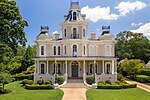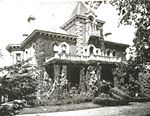T. Q. Donaldson House
Houses completed in 1863Houses in Greenville, South CarolinaHouses on the National Register of Historic Places in South CarolinaItalianate architecture in South CarolinaNational Register of Historic Places in Greenville, South Carolina ... and 1 more
Upstate South Carolina Registered Historic Place stubs

T. Q. Donaldson House, also known as the Dr. Davis Furman House, is a historic home located at Greenville, South Carolina. It was built about 1863, and is a two-story, frame, vernacular Italianate style cottage. It consists of a two-story rectangular block with a one-story wing and one-story rear ells. Also on the property is a contemporary three-room frame, weatherboard outbuilding built for use as a kitchen and servant's quarters. It was built by William Williams for Thomas Q. Donaldson, a lawyer and member of the South Carolina Senate from Greenville County from 1872 to 1876.It was added to the National Register of Historic Places in 1980.
Excerpt from the Wikipedia article T. Q. Donaldson House (License: CC BY-SA 3.0, Authors, Images).T. Q. Donaldson House
McDaniel Avenue, Greenville
Geographical coordinates (GPS) Address Nearby Places Show on map
Geographical coordinates (GPS)
| Latitude | Longitude |
|---|---|
| N 34.831666666667 ° | E -82.395277777778 ° |
Address
McDaniel Avenue 608
29605 Greenville
South Carolina, United States
Open on Google Maps








